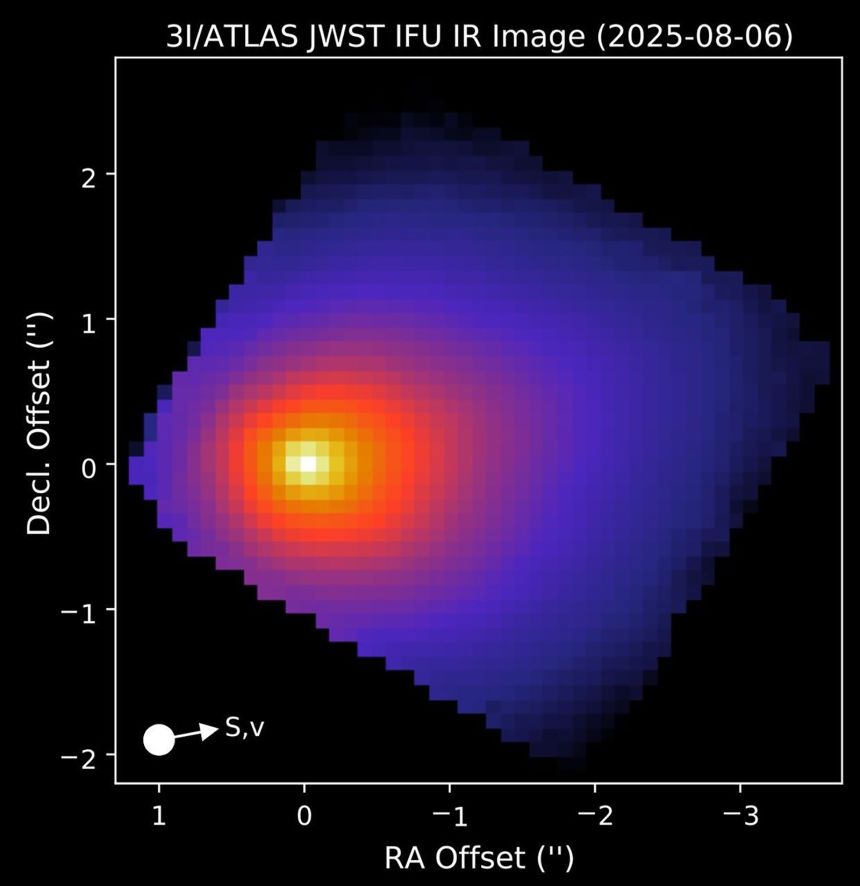An interstellar comet that originated outside our solar system just made its closest pass of the sun, setting it on an outgoing path — but it’s not leaving our cosmic neighborhood yet.
The comet, dubbed 3I/ATLAS, came within about 126 million miles (203 million kilometers) of our star, according to EarthSky. The object is currently behind the sun from the perspective of ground-based telescopes on Earth, but astronomers anticipate being able to view the comet again in a few weeks, said Darryl Seligman, assistant professor in the department of physics and astronomy at Michigan State University.
Stargazers using telescopes should be able to see the object in the predawn sky beginning November 11, according to EarthSky.
Astronomers will have a few more months to observe the comet before it begins heading out of our solar system, Seligman said.
The comet will make its closest approach of Earth on December 19, coming within about 168 million miles (270 million kilometers) — but it poses no threat to our planet, according to the European Space Agency.
Astronomers have been observing the comet, only the third known interstellar object to pass through our solar system, since its discovery on July 1.
Each observation is shedding light on this interstellar object and how different it may be from comets that originated in our solar system.

Comets are like dirty snowballs left over from the formation of solar systems.
A comet’s nucleus is its solid core, made of ice, dust and rocks. When comets travel near stars such as the sun, heat causes them to release gas and dust, which creates their signature tails.
Astronomers are interested in capturing as many observations of the comet as they can because as it nears the sun, material releasing from the object could reveal more about its composition — and the star system where it originated.
“When it gets closest to the sun, you get the most holistic view of the nucleus possible,” Seligman said. “One of the main things driving most cometary scientists is, what is the composition of the volatiles? It shows you the initial primordial material that it formed from.”
Scientists have used powerful tools, such as the Hubble Space and James Webb Space telescopes, along with a multitude of space-based missions, such as SPHEREx, to study the comet.

The SPHEREx and Webb observations detected carbon dioxide, water, carbon monoxide, carbonyl sulphide and water ice releasing from the comet as it neared the sun, according to the ESA.
Preliminary estimates indicate that the interstellar comet is 3 billion to 11 billion years old, according to a study coauthored by Seligman and Aster Taylor, a doctoral student and Fannie and John Hertz Foundation Fellow at the University of Michigan, in August. For reference, our solar system is estimated to be about 4.6 billion years old.
Carbon dioxide turns directly from a solid into a gas in response to temperature changes much more easily than most elements — which means the comet has likely never been close to another star before its brush with the sun, Seligman said.

The interstellar comet faded from the view of ground-based telescopes in October, but it remained in sight for missions such as PUNCH, or Polarimeter to Unify the Corona and Heliosphere, and SOHO, or the Solar and Heliospheric Observatory. The object also made its closest approach of Mars on October 3, coming within 18.6 million miles (30 million kilometers) of the red planet — and the spacecraft orbiting it.
While the government shutdown has prevented data sharing from any NASA missions that have observed the comet since October 1, the ESA’s Mars Express and ExoMars Trace Gas Orbiter attempted to capture views of 3I/ATLAS in October.
The cameras aboard those missions are designed to study the relatively close, bright surface of Mars, but ExoMars Trace Gas Orbiter managed to observe the comet as a fuzzy white dot.
“This was a very challenging observation for the instrument,” Nick Thomas, principal investigator of the orbiter’s camera, said in a statement, noting the comet is around 10,000 to 100,000 times “fainter than our usual target.”
ESA’s Jupiter Icy Moons Explorer, or Juice, will also attempt to observe 3I/ATLAS in November using multiple instruments despite the comet being farther from the spacecraft than it was when observed by the Mars orbiters. But astronomers don’t expect to receive the observations until February due to the rate at which the spacecraft is sending data back to Earth.
“We’ve got several more months to observe it,” Seligman said. “And there’s going to be amazing science that comes out.”
Sign up for CNN’s Wonder Theory science newsletter. Explore the universe with news on fascinating discoveries, scientific advancements and more.
First Appeared on
Source link













